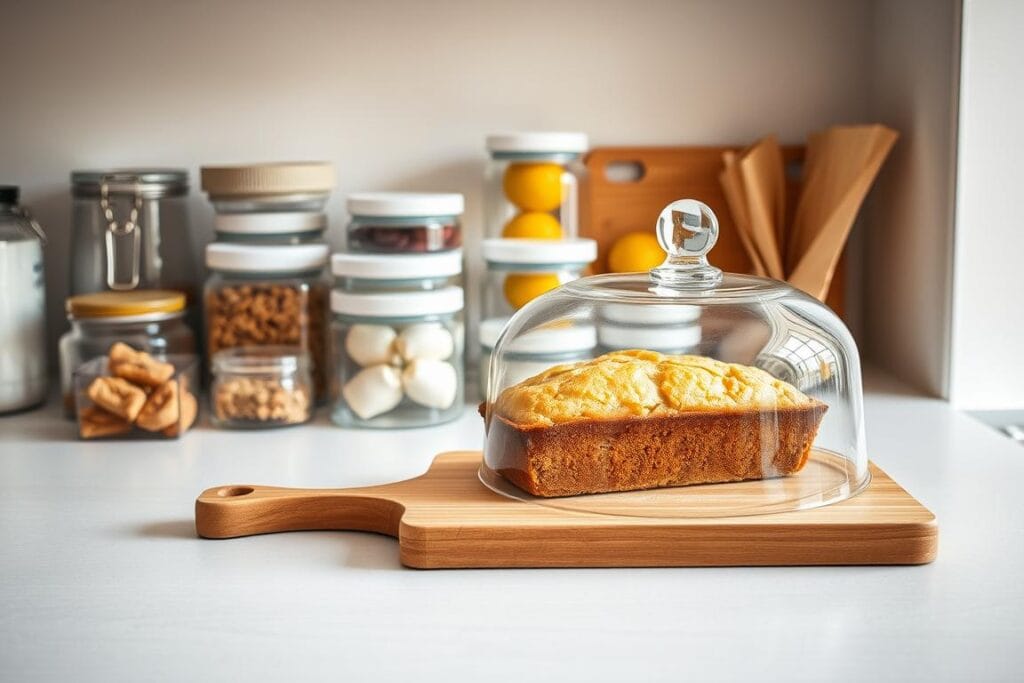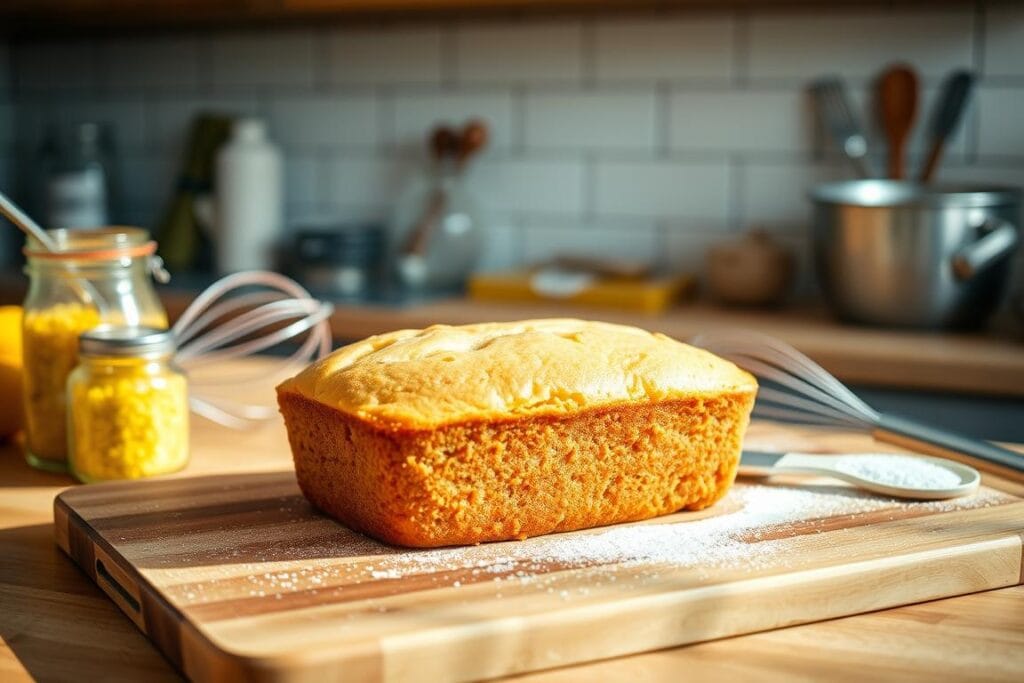Irresistible Lemon Loaf: A Zesty Treat
The first time I took a golden lemon loaf out of the oven, the kitchen was filled with a citrusy scent. It reminded me of sunny Mediterranean orchards. This moment started my lifelong love for this vibrant citrus bread, which has become my go-to comfort dessert.
A classic lemon loaf is more than just a cake. It’s a culinary journey that balances tangy and sweet. Whether you’re new to baking or have years of experience, this lemon cake will take your desserts to the next level. It offers a bright, zesty flavor and a moist crumb that’s hard to resist.
Picture cutting into a slice of perfectly baked lemon loaf. Each bite is filled with intense citrus flavors and a soft texture. This isn’t just another recipe. It’s your chance to make bakery-quality treats right in your kitchen.
Key Takeaways
- Lemon loaf combines tangy and sweet flavors perfectly
- Easy to make with basic baking ingredients
- Versatile dessert for any occasion
- Brings professional bakery quality to home kitchens
- Can be customized with various citrus variations
The Perfect Lemon Loaf: An Introduction
Explore the enchanting world of lemon desserts that have won hearts for ages. A lemon pound cake is more than a simple treat. It’s a journey of flavors, blending sweet and tangy into a zesty loaf.
What Makes a Lemon Loaf Special
A standout lemon dessert has unique qualities. The best lemon loaf has:
- Bright, zesty citrus flavor
- Moist and tender crumb
- Balanced sweetness and tartness
- Aromatic lemon zest throughout
A Slice of Citrus History
Citrus desserts have a long history, dating back to the 18th century. European bakers first mixed lemon into cakes, creating amazing treats. The lemon loaf grew from these traditions, loved by many around the world.
Why This Recipe Stands Out
Our lemon loaf recipe is special because of three key points:
- Intense lemon flavor using fresh zest
- Perfect moisture balance
- Artisan baking techniques
Whether you love baking or enjoy desserts, this zesty loaf will brighten your kitchen with every slice.
Essential Ingredients for Your Zesty Creation
Making the perfect lemon sweet bread starts with choosing top-notch ingredients. Your journey in lemon baking begins with knowing each part’s role. This makes your loaf moist and flavorful, exciting your taste buds.
The base of a fantastic lemon loaf includes several key ingredients:
- All-purpose flour: Gives your lemon sweet bread structure and volume
- Granulated sugar: Adds sweetness and makes the crumb tender
- Large eggs: Hold ingredients together and add richness
- Unsalted butter: Adds flavor and keeps the bread moist
- Fresh lemon juice: Brings a bright, zesty taste
- Lemon zest: Boosts citrus flavor
For extra moisture, add sour cream or Greek yogurt to your recipe. These ingredients make your sweet bread tender and soft, taking it from good to amazing.
Choose bright, firm lemons with smooth skin for the best zest. Organic lemons are best for zesting because they haven’t been treated with wax or harsh chemicals. Roll the lemon on your countertop before zesting for more oils and flavor.
Pro tip: Always use fresh ingredients for the most vibrant lemon sweet bread experience!
Kitchen Tools and Equipment Needed
To make a tasty lemon quick bread, you need the right tools. Having the right kitchen gear is key to a moist, flavorful loaf. It will surely impress your loved ones.
Start your lemon quick bread journey by getting the essential tools. These tools will make your baking smooth and fun.
Must-Have Baking Tools
- 9×5-inch Loaf Pan: The cornerstone of your lemon baking adventure
- Large Mixing Bowls: For combining ingredients thoroughly
- Whisk or Electric Mixer: Ensures smooth batter consistency
- Zester or Grater: Critical for extracting fresh lemon zest
- Cooling Rack: Allows proper air circulation after baking
Optional Equipment for Enhanced Baking
- Silicone Spatula: For scraping every bit of batter
- Digital Kitchen Scale: Precise ingredient measurement
- Parchment Paper: Easy loaf removal and cleanup
- Citrus Juicer: Extract maximum lemon juice
Measuring Tools Guide
| Measuring Tool | Purpose in Lemon Baking | Recommended Type |
|---|---|---|
| Liquid Measuring Cup | Accurate liquid ingredient measurement | Clear glass with measurements |
| Dry Measuring Cups | Precise dry ingredient quantities | Stainless steel set |
| Measuring Spoons | Small ingredient measurements | Nested metal set |
Quality measuring tools make a big difference in lemon quick bread. They help you achieve consistent, delicious results.
Mastering the Art of Lemon Zesting

Creating a perfect lemon dessert starts with understanding the magic of lemon zest. The bright yellow outer layer of a lemon contains powerful essential oils, which transform an ordinary zesty loaf into an extraordinary culinary experience.
Selecting the right tools is key for effective zesting. You have a few main options:
- Microplane grater
- Fine zester
- Citrus zester with channel knife
When zesting, remember these key techniques:
- Use firm but gentle pressure
- Rotate the lemon as you zest
- Avoid the white pit underneath
Pro tip for your lemon dessert: Always zest before juicing. This method ensures you capture maximum flavor and makes the zesting process easier.
| Zesting Tool | Best For | Difficulty Level |
|---|---|---|
| Microplane | Fine, delicate zest | Easy |
| Channel Knife | Decorative strips | Moderate |
| Box Grater | Large volume zesting | Challenging |
Store your freshly zested lemon zest in an airtight container in the refrigerator. It will stay fresh for about a week. This is perfect for your next zesty loaf creation.
Step-by-Step Mixing Technique
Learning to bake a lemon cake starts with the proper mixing technique. The success of your cake depends on how well you mix the ingredients. This will help you make a light, fluffy, and tasty treat.
The secret to a great lemon cake is in the mixing. Each step is essential for the right texture and flavor.
Proper Ingredient Temperature
Temperature is key in lemon baking. Here’s how to prepare your ingredients:
- Butter should be softened to room temperature
- Eggs work best when they’re not directly from the refrigerator
- Measure ingredients precisely before starting
“Room temperature ingredients blend more smoothly and create a more uniform batter.” – Professional Bakers’ Tip
Mixing Order and Tips
Your mixing strategy is critical. Here’s a good approach:
- Cream butter and sugar until light and fluffy
- Add eggs one at a time, fully incorporating each
- Alternate dry and wet ingredients gently
- Mix until just combined to prevent a tough texture
Common Mixing Mistakes to Avoid
Avoid these common mistakes to prevent baking mishaps:
- Overmixing the batter
- Using cold ingredients
- Rushing the creaming process
- Adding ingredients too quickly
By following these techniques, you’ll make a moist, tender lemon cake full of citrusy flavor. Remember, practice makes perfect in lemon baking!
The Perfect Baking Temperature and Timing
Baking the perfect lemon pound cake needs precision and care. The success of your lemon sweet bread depends on the correct oven temperature and timing. Most home bakers aim for a golden-brown outside and a moist inside.
Choosing the correct baking temperature is key for your lemon pound cake. Professional bakers suggest a consistent temperature of 350°F (175°C). This temperature helps the lemon sweet bread cook evenly without burning the outside.
- Preheat your oven for at least 15 minutes
- Use an oven thermometer to verify the actual temperature
- Place the lemon pound cake in the center rack
Baking time usually takes between 50 and 60 minutes. Visual cues are your best friend when checking if it’s done. Look for a golden-brown top and edges that slightly pull away from the pan’s sides.
The toothpick test is the most reliable way to check if your lemon sweet bread is ready. Insert a toothpick into the cake’s center. If it comes out clean or with minimal crumbs, it’s perfectly baked.
“Patience and precision create the most delicious lemon loaf” – Baking Experts
Oven variations can affect baking results. Some ovens run hotter or cooler. Always watch your lemon pound cake closely during the final 10-15 minutes of baking.
Creating the Ultimate Lemon Glaze
The crowning glory of any zesty loaf is its glaze. With the right glaze, a perfect lemon dessert turns from good to extraordinary. Your homemade lemon loaf needs a glaze that matches its bright, citrusy flavor and adds a professional touch.
A well-crafted lemon glaze adds moisture, enhances flavor, and makes your zesty loaf look irresistible. It brings several key elements to your dessert.
Glaze Consistency Tips
Getting the perfect glaze consistency is an art. Here are some expert tips:
- Start with powdered sugar as your base ingredient
- Use fresh lemon juice for maximum flavor
- Adjust thickness by adding sugar or juice a little at a time
Application Techniques
Your glaze application can make or break your lemon dessert’s look. Try these methods:
- Drizzling: Create elegant zigzag patterns
- Brushing: Ensure even coverage
- Pouring: Completely coat the zesty loaf
| Glaze Consistency | Technique | Best Used For |
|---|---|---|
| Thin | Drizzling | Decorative designs |
| Medium | Brushing | Even coating |
| Thick | Pouring | Complete coverage |
“The secret to an amazing lemon loaf is in the glaze – it’s the final touch that elevates your dessert from homemade to gourmet.” – Pastry Chef Recommendation
Pro tip: Always let your zesty loaf cool slightly before applying the glaze. This prevents it from becoming too runny or soaking into the cake.
Storage and Freshness Tips

Keeping your homemade lemon loaf fresh is key. With the right storage, a well-baked lemon cake can stay tasty for days.
Your lemon loaf can stay fresh at room temperature for 3-5 days. Here are some tips to keep it moist and tasty:
- Wrap the lemon loaf tightly in plastic wrap
- Store in an airtight container
- Keep away from direct sunlight and heat
- Place on a cool, dry countertop
Freezing is a great way to keep your lemon loaf fresh for longer. You can freeze it for up to 3 months without losing its flavor. Wrap it in plastic wrap, then put it in a freezer-safe bag to avoid freezer burn.
Ready to enjoy your frozen lemon loaf? Here’s how to thaw it:
- Remove from freezer and let sit at room temperature
- Unwrap carefully to prevent moisture buildup
- Allow 1-2 hours for complete thawing
- Refresh with a light dusting of powdered sugar
Pro tip: If your lemon loaf gets dry, try brushing it with a lemon syrup. It’s made from lemon juice and sugar. This will add moisture and a burst of citrus flavor.
Variations and Creative Twists
Take your citrus bread to new heights with exciting variations. These changes can turn your lemon loaf into a journey of flavors. Every baker can make it their own, matching it to their taste and dietary needs.
Changing up your lemon dessert is easy. Just a few tweaks can bring out new tastes that will amaze you.
Seasonal Flavor Inspirations
Seasonal twists can make your citrus bread even better. Try these ideas:
- Summer berries: Fresh blueberries or raspberries
- Autumn spices: Cinnamon and nutmeg
- Winter warmth: Candied ginger or cranberries
- Spring freshness: Lavender or elderflower
Dietary Modification Options
Make your lemon loaf fit any diet without losing flavor.
| Dietary Need | Ingredient Substitution |
|---|---|
| Gluten-Free | Almond flour or gluten-free all-purpose blend |
| Vegan | Coconut oil, flax eggs, plant-based milk |
| Low-Sugar | Stevia or monk fruit sweetener |
“Baking is about sharing love through creativity and adaptation.” – Unknown Baker
Don’t be afraid to try these ideas. Your lemon dessert can become a special creation that shows off your unique style.
Troubleshooting Common Issues

Getting your lemon pound cake just right can be tough. Every baker faces challenges when making this sweet treat. Knowing the common problems helps you make a cake that’s always a hit.
Identifying Lemon Loaf Challenges
Here are some common issues you might face:
- Sunken middle
- Dry texture
- Uneven baking
- Cracked surface
Resolving Texture and Density Problems
The wrong ingredient amounts often result in a dense or dry lemon loaf. Getting the measurements right is key in lemon baking. Use special measuring cups for dry and wet ingredients to avoid mistakes.
Baking Temperature and Placement
The oven’s temperature is very important for your lemon pound cake. An incorrectly calibrated oven can mess up the baking. Try using an oven thermometer to check the real temperature.
- Preheat the oven thoroughly before baking
- Place the cake in the center rack
- Rotate the pan halfway through baking
Moisture and Flavor Retention
To keep your lemon pound cake moist, try these tips:
- Check ingredient freshness
- Use room-temperature eggs
- Don’t overmix batter
- Test the cake with a toothpick for doneness
With practice and careful attention, you’ll master making a perfect lemon pound cake every time.
Serving Suggestions and Pairings
Your lemon sweet bread is more than just a simple treat. The proper presentation and pairing can make it unforgettable. It will delight all your senses.
Perfect Beverage Companions
Find the perfect drink to go with your lemon dessert:
- Hot Beverages
- Earl Grey tea
- Chamomile tea
- Espresso
- Cappuccino
- Cold Beverages
- Fresh lemonade
- Iced green tea
- Sparkling water with lemon
- Cold brew coffee
Creative Garnishing Ideas
Make your lemon sweet bread stand out with these garnishes:
- Dust with powdered sugar
- Add fresh berries on the side
- Drizzle with light lemon glaze
- Sprinkle candied lemon zest
- Top with whipped cream
These ideas will make it special, whether it’s for breakfast or afternoon tea. Your guests will remember it.
Conclusion
Baking a zesty lemon loaf is more than just following a recipe. It’s about creating a delicious experience that brings joy to your kitchen. Your homemade lemon quick bread is a perfect blend of skill and creativity. Each slice tells a story of careful preparation and passionate baking.
The lemon loaf you’ve learned to make is a versatile treat that can brighten any occasion. Whether serving it for breakfast, afternoon tea, or as a sweet dessert, this recipe offers endless possibilities. Try our discussed variations and add your unique twist to the classic lemon loaf.
We invite you to share your baking adventures. Did you discover a new flavor combination? Did your first attempt turn out perfectly? Your feedback and experiences can inspire other home bakers. Tag your lemon loaf creations on social media and connect with a community of passionate bakers who love creating delectable citrus treats.
Remember, baking is an art that improves with practice. You’ll become more confident and skilled each time you make this lemon quick bread. Embrace the process, enjoy the delightful aroma filling your kitchen, and most importantly, savor every delicious bite of your homemade lemon loaf.
FAQ
How long does a lemon loaf stay fresh?
Your lemon loaf will last 3-4 days at room temperature in an airtight container. Refrigeration extends its life to 5-7 days. Freezing it for 2-3 months is also an option, with careful wrapping and storage.
Can I use bottled lemon juice instead of fresh lemons?
Bottled lemon juice works in a pinch, but fresh lemons are better. They offer more vibrant flavor and zest. Choose 100% pure lemon juice without additives.
How can I make my lemon loaf gluten-free?
Use a gluten-free flour blend for a gluten-free loaf. Add xanthan gum if needed for texture.
Why did my lemon loaf turn out dense and heavy?
Overmixing or cold ingredients can make a dense loaf. Mix just until combined and use room temperature ingredients. Fresh leavening agents also help.
Can I add other fruits to my lemon loaf?
Yes! Blueberries, raspberries, or poppy seeds are great additions. Fold in 1 cup of berries gently before baking.
How do I know when my lemon loaf is fully baked?
Check with the toothpick test. A clean toothpick means it’s done. The top should be golden, and it should spring back.
Can I make this lemon loaf dairy-free?
Yes, use vegetable oil or coconut oil instead of butter. Replace milk and sour cream with non-dairy alternatives.
How should I store the lemon glaze?
Store leftover glaze in an airtight container in the fridge for up to 5 days. Let it come to room temperature before using. You might need to adjust the consistency with lemon juice or sugar.

Irresistible Lemon Loaf: A Zesty Treat
- Total Time: 1 hour 10 minutes
- Yield: 1 loaf (8–10 slices) 1x
- Diet: Vegetarian
Description
This irresistible lemon loaf is a moist, bakery-style treat bursting with fresh citrus flavor. With a bright lemon glaze and tender crumb, it’s a sweet, tangy comfort dessert perfect for any occasion.
Ingredients
For the Lemon Loaf:
1 ½ cups all-purpose flour
1 cup granulated sugar
½ cup unsalted butter, softened
2 large eggs
¼ cup fresh lemon juice
1 tablespoon lemon zest
½ cup sour cream or Greek yogurt
1 teaspoon baking powder
½ teaspoon baking soda
¼ teaspoon salt
1 teaspoon vanilla extract
For the Lemon Glaze:
1 cup powdered sugar
2–3 tablespoons fresh lemon juice
Instructions
Preheat oven to 350°F (175°C). Grease and flour a 9×5-inch loaf pan or line with parchment paper.
In a large bowl, cream together softened butter and sugar until light and fluffy.
Beat in eggs one at a time, then add lemon juice, lemon zest, sour cream, and vanilla extract. Mix until combined.
In a separate bowl, whisk flour, baking powder, baking soda, and salt.
Gradually add dry ingredients to the wet mixture, stirring until just combined. Do not overmix.
Pour batter into the prepared loaf pan. Smooth the top with a spatula.
Bake for 50–60 minutes or until a toothpick inserted in the center comes clean.
Cool in the pan for 10 minutes, then transfer to a wire rack to cool completely.
Mix powdered sugar and lemon juice to make the glaze. Adjust thickness as desired.
Drizzle glaze over the cooled loaf. Let set before slicing.
Notes
For extra citrus flavor, increase lemon zest to 2 tablespoons.
Use room temperature eggs and butter for a smoother batter.
Store wrapped at room temperature for 3–5 days or freeze for up to 3 months.
Add blueberries or poppy seeds for variation.
- Prep Time: 15 minutes
- Cook Time: 55 minutes
- Category: Dessert
- Method: Baking
- Cuisine: American
What Are Our Readers Saying?
There are no reviews yet. Be the first one to write one.







